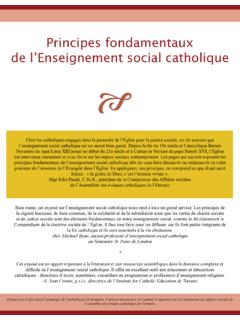Transcription of CHARACTER DEVELOPMENT AND THE VIRTUOUS …
1 1 The Education Commission of the OCCB CHARACTER DEVELOPMENT AND THE VIRTUOUS LIFE: A POSITION PAPER Introduction For the past few years, the Ministry of Education through its Secretariat for Literacy and Numeracy has been promoting a province-wide initiative known as the CHARACTER DEVELOPMENT Initiative. In broad terms, this initiative seeks to integrate within publicly-funded education a more holistic approach to pedagogy which recognizes the importance of morality in the growth of children and teachers. The ministry identifies the following specific goals which it seeks to attain through this initiative: improved academic achievement; improved interpersonal relationships; safe and orderly schools; reduced behavioural problems; improved life preparation; improved employability skills; positive school cultures; and responsible citizenship in classrooms, schools and communities.
2 At this moment, the principal reference document concerning this initiative is entitled Finding Common Ground, published in October, 2006. This initiative echoes similar efforts that find their origins in the United States of America. The rejection of a religion-based approach to moral education in the American public schools of the 1960 s and the failure of the therapy-based Values Clarification approach of the 1980 s left a vacuum in the educational world which made it difficult to address pressing issues of the 1990 s: growing violence in schools, alarming rates of teenaged pregnancy, drug addiction and drop-outs, a seeming loss of a common vision of good citizenship.
3 In the United States, a number of institutions and publishers have embraced the CHARACTER DEVELOPMENT approach over the past decade, developing various theories, programs and ressources for use in schools and other educational milieus. In Canada, the Ministry of Education of the province of Alberta, for example, has invested heavily in this approach. Ontario is a relative late-comer to the movement. The question arises as to how this approach can best be integrated into the life of the publicly-funded Catholic schools of Ontario. At first, some felt this initiative was redundant given the well-established tradition of moral education in Catholic schools. Recently, the consensus has shifted and most feel that we must fully engage this initiative while remaining faithful to our own tradition.
4 The following considerations present a theoretical background as well as principles that Catholic educators should follow as they respond to the CHARACTER DEVELOPMENT Initiative and seek to enrich it as they integrate it in our own schools. 2 1. CHARACTER and the acquisition of virtues The Canadian philosopher Christine McKinnon, in her book CHARACTER , Virtue Theories and the Vices, [Peterborough: Broadview Press, c1999] suggests that the concept of CHARACTER can be best understood when compared with that of personality. For her, personality is something of a given, the matter from which we must build CHARACTER . Personality is what I am, not something I choose and not something that can be evaluated ethically.
5 On the other hand, CHARACTER is something that is constructed, something I choose more or less deliberately. It is what I make of myself. This can be evaluated ethically. She writes: A person s CHARACTER is a complex of innate dispositions, shaped by environmental influences as well as traits acquired through habituation, reasoned assessments and voluntary choices [p. 66].. To talk about a person s CHARACTER is to talk about a complex of virtues and vices and more ethically neutral skills, abilities and dispositions she possesses as well as to talk about the ways she values them and identifies with them and the roles she has constructed for them in her life [p. 71].
6 For McKinnon, the acquisition of virtues is one of the fundamental elements in the DEVELOPMENT of CHARACTER . Following her lead, we suggest that the concept of virtue, a concept central to Catholic moral doctrine, is key in linking the CHARACTER DEVELOPMENT Initiative to the Catholic school education project. 2. A Short History of the Concept of Virtue The concept of virtue, though present in Scripture, is not central to the Bible s reflection on human action. In fact, we rarely find the word virtue in the Bible. It really owes its place in Western thought to the ancient Greek philosophers. Plato and Aristotle both developed this concept as they sought to answer the question: How does one lead a good life?
7 In Greek, the word we translate by virtue is ar te, which speaks of strength and excellence. For Plato and Aristotle, virtues were vital strengths that tended towards excellence. Plato distinguished four foundational, or cardinal, virtues: prudence, strength, temperance and justice. These were seen as grounding the possibility of all the other virtues, related as they were to four different aspects of the human being. In the fourth century, Saint Ambrose and Saint Augustine embraced this philosophical tradition. They both found in neo-platonism a philosophy that resonated with the Christian experience. Augustine reworked the concept of virtue from a solidly biblical perspective in such a way that faith, hope and love become the true foundational virtues, rooted in the encounter of God in Jesus-Christ.
8 These three are known as the theological virtues, for they cannot exist outside a relationship with God. They reorient the traditional cardinal virtues and lead to the consideration of new virtues such as humility and forgiveness. 3 In the thirteenth century, Saint Thomas Aquinas adopted Augustine s sevenfold structure in the second part of his Summa theologica. There, he defined virtue as a habitus, a dynamic way of being and acting that grounds freedom and is necessary for freedom s growth. He developed a theology of morality based on the attraction of truth and goodness, on the desire for happiness, centred on the virtues and turned towards quality and perfection.
9 He did this in harmony with the Holy Scriptures and the existing theological tradition. In later centuries, philosophers of the Enlightenment would abandon this approach. They were more interested in the concrete decisions or actions undertaken by human persons than in the human person as a subject. This led them to found morality on the concepts of law and obligation. Their focus was on duty rather than desire. In such an approach, there is little place for the concept of virtue. The thought of Emmanuel Kant is representative of such an approach. It must be recognized that this approach also influenced Catholic moral theology. The philosophia perennis taught in the seminaries of the first half of the twentieth century, shaped as it was by the writings of Thomas Aquinas, still presented virtue as a foundational concept in moral theology.
10 Yet the manuals did not reflect the power of the concept in Thomas s theology. What is more, the attention to individual acts required of confession and typical of many confessors manuals (particularly in the school of casuistry promoted by the Jesuits) also turned Catholic thought away from a vibrant spirituality of virtue. The end of the twentieth century saw philosophers in the English-speaking world react to a morality of law and obligation and turn once again to the concept of virtue. Today, we can speak of a real turn in moral philosophy, captured by the title virtue ethics. Among its principle proponents we can find Alasdair MacIntyre, Iris Murdoch, Reinhold Niebuhr, Charles Taylor, Martha Nussbaum, Bernard Williams, John Casey and William Bennet.







